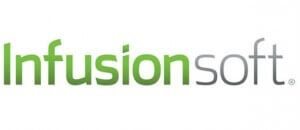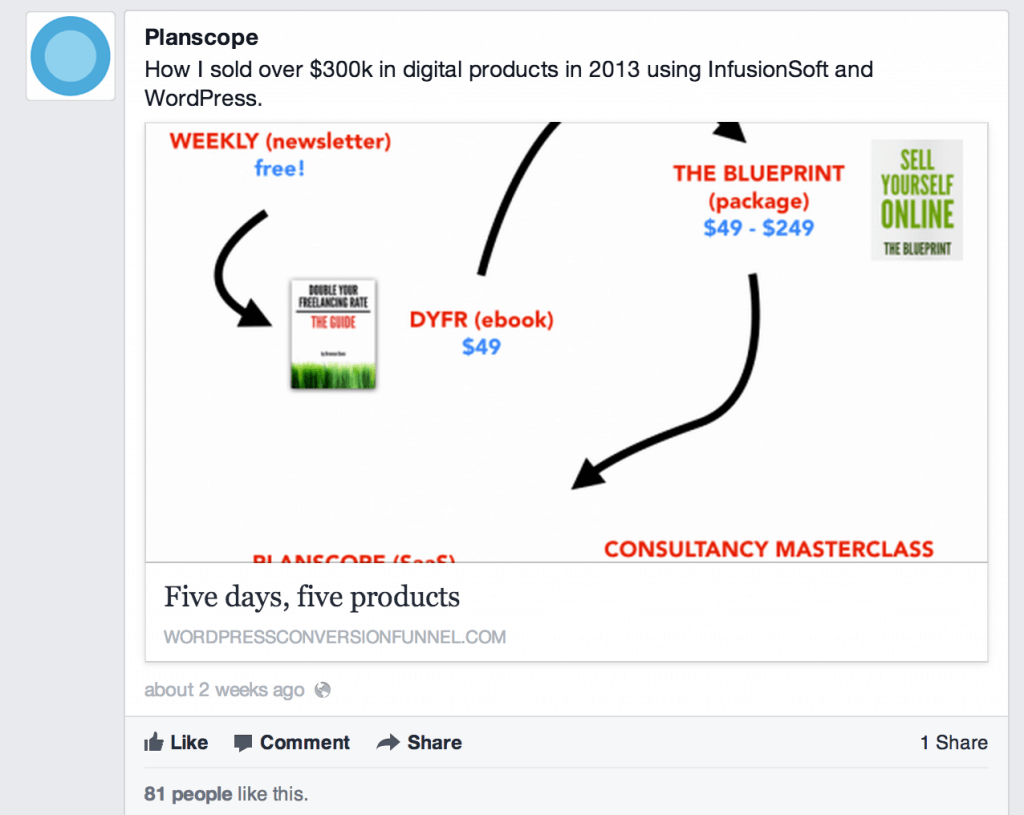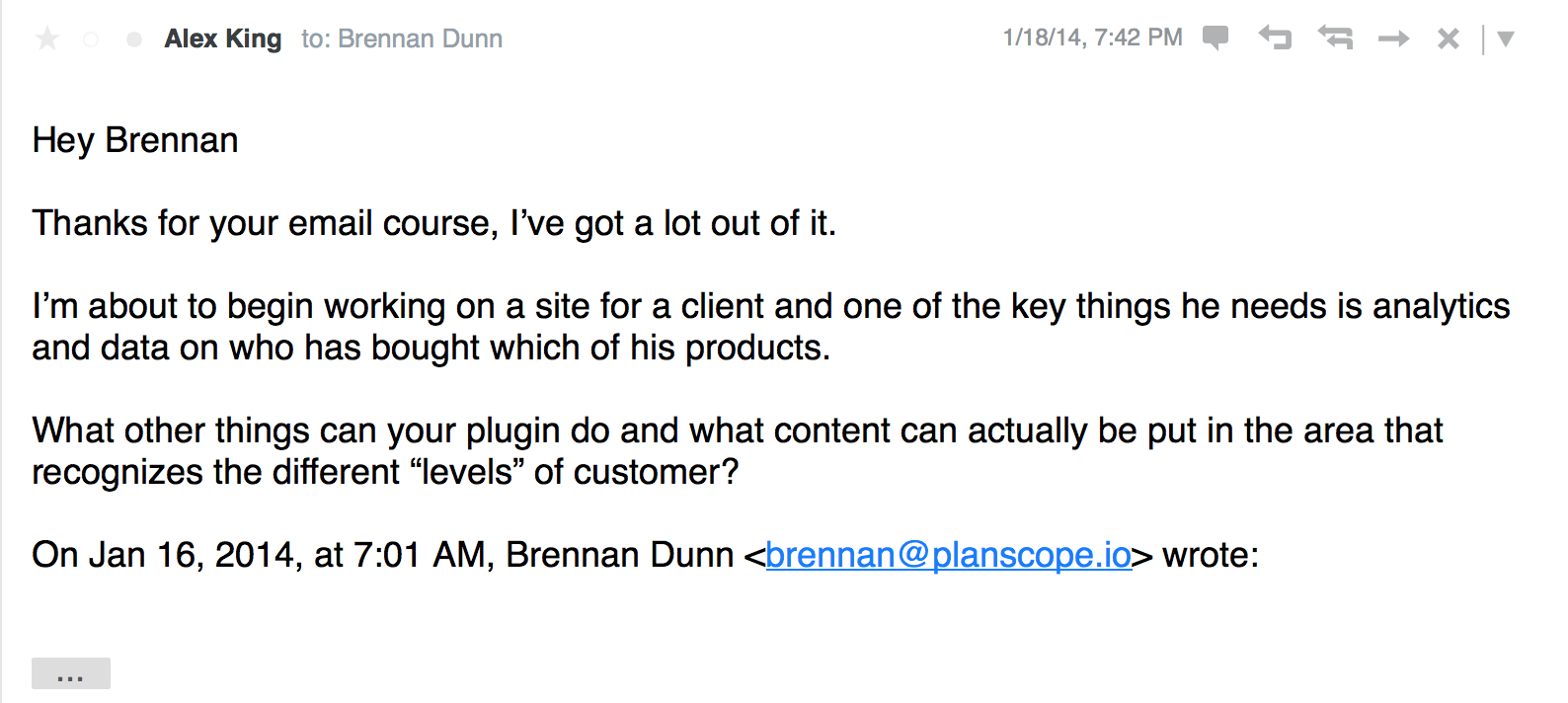When you see someone with thousands of newsletter subscribers, Twitter followers, or whatever other statistic often equates with success, it’s easy to get discouraged and give up on starting or launching a new product to help augment (or even replace) your freelancing income.
Why would anyone buy that book you’ve been writing if no one knows you?
How will you get any customers when you have no traffic?
You’re no expert or authority, why would anyone take your advice?
Today I want to talk about how I took a raw idea, built a product, and sold it to a handful of customers in less than 3 days.
I applied everything I’ve learned in selling hundreds of thousands of dollars in products over the last few years to build and market my new product — but in a way, I was starting from scratch. I had to sell this product to a brand new audience that I had zero relationship with.
So here’s exactly how I did it. While I don’t expect nor think that this should be used as a step-by-step recipe for selling your first product, I’m hoping that I leave you a few minutes from now with a little more clarity and direction. And if I don’t shatter the myth of “you need to be popular / have an audience / be an expert to sell products” then I haven’t done my job with this post.
The “Idea”: The Inverse Of A Real Problem
A few years ago, I took Amy Hoy’s 30×500, which counters all the “build a billion-dollar startup!” junk out there with a realistic framework for building products. Amy’s course was pivotal in helping me figure out how to create products, but if there’s one thing that really stuck with me it’s the idea that great products are born from great pains.
I run a website that is responsible for a lot of the success of my business (this blog) and use Infusionsoft to centralize all of my customer data and handle all of my email marketing. But they really never… talked well to each other. Every visitor would see the same newsletter opt-in form, regardless of whether or not the person looking at it was already subscribed.
As a business owner, it doesn’t make sense to promote my newsletter to existing subscribers. I’d much rather put a promo for my best-selling course, Double Your Freelancing Rate, in front of a new subscriber and The Blueprint for my best customers. But everyone was seeing the same, stinkin’ newsletter opt-in form.
So I was losing money by having a “dumb” website. My idea was: “What if my website was smarter than this?” At this point, I didn’t care about how my website could be smarter, I just wanted to know what would happen to my business with this problem stripped away. What could tomorrow look like for me? (Again, straight out of 30×500.)
A lot of people might start with the problem and immediately start thinking about what needs to be created to solve it. And as creatives, this is no surprise. After all, we build stuff for a living. But if you’re hoping to lower the risk of failure, stepping away from the code (or the words, or the design, or whatever) is a smart move.
Latching Onto Cash Flow
In this episode of The Tropical MBA podcast, Damian Thompson explained how his consultancy latches onto customers who are pre-conditioned to spending money. His target audience is Infusionsoft customers, which is an advanced email marketing platform that costs thousands of dollars to set up and thousands more a year to keep running. And because his customers have serious enough businesses that they’re able to spend this much a year on email marketing, they’re typically OK with spending a little more on Damian to optimize their efforts.

I needed to know that I’d be selling to people who have problems big enough to spend money on. Asking a freemium Mailchimp user to spend a few hundred on my product is marketing suicide; but putting that same product in front of someone who spends a minimum of $300 a month on email marketing should work. Plus, I’d be able to anchor the cost of my product against the cost of Infusionsoft.
Great. So by now, I had pinpointed a problem that I know was costing at least a few people money, and the people who I was targeting were the sort who paid money to solve business problems.
Who Else Had This Problem?
I wanted to sell to fellow Infusionsoft customers, and I needed to make sure I wasn’t the only one who thought this problem was bad for business.
Facebook is an incredibly easy (and cheap) way to find customers if you use it correctly. In just a few minutes, you can target a specific group of people and have whatever you want to show up in their newsfeed.

You’re probably wondering what product I was promoting. A ha! That’s the thing — I wasn’t promoting a product.
There are a few reasons for this. First (and most obvious), I didn’t have a product yet. But I did have a problem, and I knew what things would look like if that problem went away. And second, rarely are people in a buying mood when browsing Facebook. They’re mentally checked out and flipping through baby pictures and Super Bowl stuff.
I ended up advertising a five-day email course that explored how I cross-promoted my products. Here’s the ad:

Instead of asking for someone to whip out a credit card and buy something, I’m asking for just an email address. This is a much easier sell for someone who’s casually browsing Facebook, and allows me to provide value to a new audience of future customers before I actually have anything to sell.
Before writing a line of code, I wrote Day #1 of my email course and gained a dozen or so subscribers within 24 hours.
Designing The Product
Now that my course was harvesting email addresses, I went to work actually writing code and building the product. I ended up building a WordPress plugin, but what I built and how I built it is immaterial here. All that matters was that I was constrained by the solution and couldn’t be led astray by “wouldn’t it be cool IF…”, which would leave me with features that wouldn’t get me any closer to my goal.
But while I was writing code, I was also personally emailing all of the new subscribers. I wanted to know who they were, how Infusionsoft played into their eCommerce strategy, and — in their own words — how they described the disconnect between their WordPress website and Infusionsoft.
I knew that by the end of the course, I wanted to sell a product (or at least accept pre-orders of whatever I had in development.) And the best way to sell is to let the prospect understand that you know them and what they’re struggling with. This is a not-so-secret tactic I employ in all of the website copy on my marketing sites — it’s written “you-speak” (that is, real words from real customers), not “Brennan-speak”.
The Facebook ads went up on Friday afternoon, and later that night I started writing code. Over the next two days, I made sure I was always ahead of the next course email and fleshed out a basic plugin that delivered the solution that I’d identified.
Awesome, things were panning out nicely and the email course list was growing.
Making The First Sale
You’ll remember that I had a number of active conversations happening as I developed the plugin. On Monday, exactly 3 days after launching the email course, I elevated the conversation I was having with a few of the people who had joined my list.
“Hey, I have a WordPress plugin that will help you increase your sales by promoting the right products to the right people. You can buy it right now for $197, and I’ll include a year of free updates. And if it doesn’t work the way you need it to, I’ll refund you in full.”
Yes, this is high-touch sales. I didn’t wake up with random people sending me money for my plugin that Monday. But this process helped me learn what objections people had to getting this solution, often spanning over quite a few emails, which would really be helpful when I switched the marketing site on in a few hours.

Needless to say, it worked. Two people who had first come across me the Friday before were now ready to fork over $197 each to grab this three-day-old WordPress plugin. Not only would this cover (and then some) my Facebook ad spend, but people had found enough value in solving this specific pain that they were willing to pay to have it go away.
Removing Myself From The Picture
My final goal was to fully automate the sales and fulfillment process of this new product. Propelled by the two sales I had gained that Monday, I was ready to recycle what I had learned in closing these deals into both the marketing site and the email course.
By then, the first batch of subscribers to my email course were about to get Day #4 (which was being written just-in-time,) which is where I made the case for buying the plugin. The first three days were dedicated to why someone should care about tying together their email marketing with their website, and the fourth and fifth days were the how — either hire a developer for lots of money and lots of risks, do it yourself, or pay me $197.
So the next day, at a little after 10 am Eastern time (when the email course went out each day), I had my first fully anonymous sale. Someone I’d never actually spoken to, but who had been following my course for the last few days, had just sent me money.
This was a HUGE milestone for me. I stuck some money into Facebook, and out came more money on the other end. Since launching the course, I’ve been averaging about a 4% conversion rate. Now, I’m not exactly swimming in a vault of gold coins yet. For every 100 opt-ins, I’m spending $600 and making $788. (At the time of writing this post, I had made a little over a thousand dollars with about a 25% profit margin.)
But here’s the thing: I’ve shipped. I’m collecting data. My margin will only get bigger as I learn from that data and tailor the course and marketing site appropriately. I can experiment with new marketing channels. I have customers, I have revenue, and I have an itty bitty money-making machine.
The overwhelming majority of people don’t ever make a dime off products because they refuse to ship, or they launch the wrong thing, or they’re waiting for that big press coverage (which never comes) to get customers. Whatever the excuse, tons of people just like me either don’t start, don’t ship, or throw in the towel prematurely.
I want you to really try to think about the story I just told and try to think about how you can throw what you’re good at against a problem you know about…
What problems have you solved for clients in the past?
And why did your clients pay you to fix them?
How could you take that problem and build something that could help others — without having your time as a required input? And more importantly, how can you put your solution in front of the right people? And don’t worry about building software, especially if that’s not your thing. Information is just as valid — information can help solve problems, it just requires the reader to do something with it.

Your goal should be to create your own money machine. If I were still freelancing, I wouldn’t be able to live off the profits that WordPress Conversion Funnel is paying me today. But over the last several years, I’ve created a lot of little money machines, and some of these have grown steadily over time (to the tune of over $300k back in 2013.) This has allowed me to replace my income as a consultant — but that’s an ambitious goal, and I don’t think it should be yours.
How can you add $100 to your monthly income this week?
It might not seem like much, but making the jump from zero product income to just $100 a month is often more difficult than going from $100 to $1,000, or even $1,000 to $10,000.
If you can get a few people who aren’t friends or family to find your product, determine that your offer worth paying for, and actually send you money in exchange for said product, you’ll be off to an awesome start. Next, you just need to figure out how to optimize your messaging, tweak your value proposition, and expand your sales channels and your sales will continue to grow, and grow, and grow.